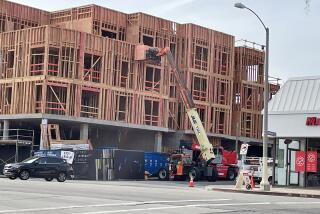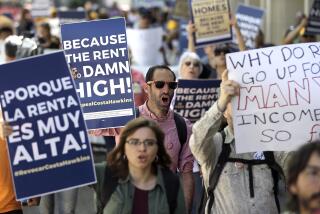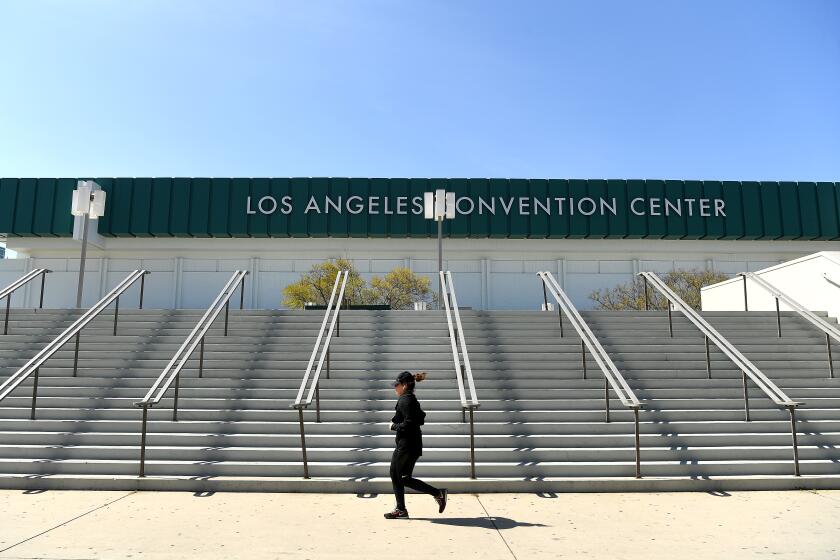Slow-Growth Debate Keyed to 3 Concerns : Props. H, J Offer No Quick Fix to Problems
- Share via
With less than four weeks remaining until San Diego residents vote on two slow-growth ballot measures, increasingly bitter debate is focusing on three key questions at the heart of the unprecedented effort to limit home building in a major American city.
Amid a torrent of competing claims, voters are confronting these issues:
* Will Proposition H or Proposition J actually slow growth and ameliorate such things as traffic congestion, vanishing open space and air pollution?
* Will the measures raise home prices and rents?
* Will they harm the economy and increase unemployment?
The answers vary depending on which proposition is considered and which analyst is consulted. But in each case the effects probably would be far milder and more gradual than the gloom and doom predictions of the proposition’s detractors.
Dominant Local Issue in ’88
Regardless of whether either measure is approved, voters should not expect quick progress in the problems that have made growth the dominant local issue in this year’s election, said architects of both plans.
Even the authors of Proposition J, regarded as the most restrictive home building cap and the only plan that would purposely slow economic growth, say city residents should not look for improvements in their lives for five years after the initiative passes.
“By the end of a five-year period, you should start to see a difference,” said Richard Carson, a UC San Diego economist who helped write Proposition J, known as the Quality of Life Initiative. “In the first couple of years, whether the city’s passes, whether ours passes, whether nothing passes, you won’t see much of a change.”
Tim O’Connell, Mayor Maureen O’Connor’s land-use adviser, cautions city residents not to anticipate any change for three years in the perception that conditions are deteriorating, and to expect only that city-sponsored Proposition H will preserve the status quo by then. Later, the city will begin to make progress improving its overwhelmed roads, schools, parks and other public facilities, he said.
‘People Willing to Fight’
“On the whole, people are happy with their quality of life and the problem is they see it disappearing,” O’Connell said. “They see they’re losing it and they’re willing to fight to keep from losing it.”
Builders, however, warn that neither initiative addresses the city’s true problem: a $1-billion shortage in the money needed to relieve traffic congestion, upgrade sewage treatment capabilities and clean up polluted shores. Money from new development is needed to help the city catch up, said Kim Kilkenny, legislative counsel for the Construction Industry Federation.
Voters “think they’re solving a problem and they’re not,” said Douglas Porter, director of development policy research for the Urban Land Institute, which is backed by development money and counts land-use planners and government officials among its members. “ . . . I think it’s a misplaced expectation.”
Proposition H, placed on the ballot by the San Diego City Council as a counter to the citizens initiative, proposes to cap home building at 7,590 annually for the next three to five years, the number of homes that the San Diego Assn. of Governments estimates will be needed to accommodate expected population growth over the same time.
Proposition J, sponsored by Citizens for Limited Growth, would limit residential construction to 7,000 to 9,000 homes in the first year after passage and gradually decrease the number to as few as 4,000 by the fourth year after the vote--if the city fails to meet tough standards for air quality, water supply, traffic congestion, trash disposal capabilities and sewage treatment. The measure would last 22 years, or until all five standards are met.
Would Slow Job Growth
Both measures include language protecting some of the city’s topography from construction, but only Proposition J calls for corresponding limits on economic growth that would gradually slow the rate at which new jobs are created.
The county Board of Supervisors and Citizens for Limited Growth have placed similar competing measures, Propositions B and D, on the ballot in an attempt to limit growth in the county’s unincorporated areas.
Though some of the data is conflicting, research conducted over the past year provides some help in sorting through the claims made by the three major campaigns on the questions facing voters.
Will Propositions H and J slow growth?
Between 1980 and 1988, city population increased by 183,170 people, nearly 21%, according to Sandag figures. In some years, population growth approached 4%, the kind of increase associated with overpopulated Third World nations.
Sandag believes that 60% of those people moved here to take jobs and 36% were born here. With public facilities in the city’s urban core failing to keep pace with that growth, crowding soon began to show up on roads, in schools and in parks.
Proposition H, however, is not designed to tackle this problem, for housing caps alone will not prevent people from coming to the city to take jobs.
“I would think that Proposition H would not slow population growth in the city of San Diego,” said Stuart Shaffer, Sandag’s deputy executive director. “Proposition H makes no attempt to slow down employment growth, and as (Sandag research) shows, most population growth comes from job growth.”
Proposition H, rather, would slow the rate of home building from the frenetic levels reached before the city enacted its 8,000-home temporary home-building cap, called the Interim Development Ordinance, late last year.
After a recession-era low of 4,012 homes were built in 1982, the city entered a torrential building boom in which 10,323 were built in 1984, 13,188 in 1985, 15,228 in 1986 and 14,019 last year.
Time to Catch Up
Cooling down that pace will allow the city some time to play catch up, its backers say, an effort that includes preserving single-family homes that are in danger of being replaced by multifamily units, and devising a plan for managing the peak-hour traffic congestion on roads and highways.
More importantly, it directs the city manager to devise a plan for building the $1 billion worth of roads, parks, fire stations and other public facilities that will be needed--and a method of paying for them.
“The city measure is much more focused on setting up mechanisms to deal with the problems,” said Cynthia Kroll, a regional economist for the Center for Real Estate and Urban Economics at the University of California, Berkeley, who helped write an analysis of housing cap strategies for the city this year. “It is much more specific in what we need to do.”
Its critics, however, note that the city plan exempts redevelopment areas and low-income housing, allowing the City Council to authorize as many homes in those categories as possible. Moreover, as Sandag noted, “by themselves, residential growth restrictions are inherently flawed . . . very restrictive and long-term housing limitations would be required to reduce the region’s population growth” so that it is receiving only its fair share of the state’s population increase.
Proposition J would couple even more restrictive housing lids with curbs on industrial and commercial expansion, creating “a gradual transition to a slower, more stable rate of growth,” said Peter Navarro, a University of San Diego economist who helped write the plan.
Would that work? Though the initiative is not clear on how to slow the pace of job creation, “I think somewhere beyond five years . . . you would see some kind of an impact on population growth,” said Sandag’s Shaffer.
But some economists and planners predict that San Diego’s population and rate of job creation will decline substantially without any intervention.
The children of the Baby Boom have been largely accommodated. Defense spending increases, which fueled much of the region’s job growth, are starting to slow. Sandag forecasts a population increase of just 107,000 by 1995 and 313,000 by 2010.
Don’t Need a Cap
More importantly, the number of jobs in the region, which have been expanding by an average of 4.2% annually between 1980 and 1988, will increase by just 2.8% annually between now and 1995, Sandag says.
“I’m not sure you need a cap,” said Berkeley’s Kroll. “I think what you need is a mechanism to deal with the problems that concern the citizens and concern them very rightly.”
Will Propositions H and J raise home prices and rents?
No credible study shows any evidence that the growth initiatives will increase home prices anywhere near as fast as they are rising now without controls--in the range of 18% to 23%, according to the latest statistics kept by the San Diego Board of Realtors.
The Berkeley study predicts a 2.5% housing price increase countywide and larger increases in the city of San Diego. Economist John Savacool, who tracks the region’s real estate market for The WEFA Group (formerly Wharton Econometrics) of Philadelphia, said that the initiatives could add 3% to 4% more to already inflating price tags.
In Davis and Petaluma, two small, Northern California towns that imposed growth curbs in the early 1970s, home prices rose 7% and 8% as a result of the limits, according to Seymour Schwartz, a UC Davis professor of environmental studies who examined the situation.
A new study conducted by real estate consultant Mountain West for the Board of Supervisors estimates that if both Propositions D and J are approved, prices could rise 27% by 1998--or 2.7% per year more than they would without restrictions.
Anticipation of the initiatives may be raising prices already.
“The fear becomes the reality,” said Russell Valone, president of Market Profiles, a market research firm that tracks home prices in subdivisions.
“If you move into the area and you want that new home, or if you live here and you want that new home, and you understand that the growth initiatives are on the November ballot, you may buy now instead of waiting until next year,” Valone said.
Harold and Debbie Walk, who rent a house in Allied Gardens, have come to that conclusion and are trying to buy their first home before Nov. 8.
“We expect that not only will the caps cause prices to rise pretty substantially, but just the anticipation (of growth controls) is causing sellers to demand even more,” said Harold, who manages foreclosed farm property for banks.
Builders note that San Diego is already the least affordable housing market in the nation when average income is compared against average monthly mortgage payments. The analysis, by the Lomas & Nettleton Co., shows that the average San Diegan spends 33.3% of his monthly income to meet those payments, a rate higher than New York City, Boston and Los Angeles, the next most expensive markets.
A report by Coldwell Banker Real Estate Consultation Services, one of the few studies to forecast the effect of the growth initiatives on rental prices, suggests that rents would increase twice as fast as they would under free market conditions and would lead to rents 18% higher than they would without restrictions.
San Diegans for Regional Traffic Solutions, the builders’ campaign committee, has twisted this statistic, sending out hundreds of thousands of mailers with the message: “Don’t Let Rents Double” in bold headline type. A spokesman for the committee said that the information will be corrected in forthcoming direct mail pieces.
Will Propositions H and J increase unemployment and harm the local economy?
Partisans and analysts are most deeply--and angrily--divided on this issue, which is the cornerstone of the campaigns being mounted by builders and civic leaders against the citizen initiatives.
Builders, for example, claim that as many as 60,000 people could lose their jobs under Proposition J because it would reduce home building by 75% from its 1986 peak.
But no neutral analyst agrees with that assessment. While they agree that the construction industry will be hit the hardest, other studies point only to decreases in the rate of job growth over time. In other words, San Diego will still experience substantial job growth regardless of what happens with local growth control measures.
The UC Berkeley study, which did not contemplate industrial and commercial restrictions, forecasts that a strict cap of 4,500 homes would reduce employment growth by just 7,000 jobs compared to free market conditions by 1995. The construction industry, which always endures cyclical fluctuations, would suffer the largest cut, but it would be just 3%.
Sandag, however, predicts a 2% to 3% increase in unemployment rates with the kinds of home building and industrial restrictions that would be imposed under Proposition J’s most stringent conditions. The decreased rate of job creation might instill competition between people who migrate here for employment and those who are born here, to the point that “some of them would be forced to leave the region for economic reasons,” the Sandag report opined.
An analysis by San Diego’s Economic Development Commission predicts that under Proposition J’s curbs on industrial and commercial development, the number of unemployed San Diegans would rise from 48,000 now to 90,000 by 2000. Navarro and Carson assert that would happen anyway as the population expands.
Challenged Thesis
The EDC’s prediction of sustained, high levels of unemployment, was challenged by groups from Citizens for Limited Growth to Ron Barbieri, managing director of the real estate consulting firm Market West, who studied the propositions for the county.
Carson and Navarro say that Proposition J would prevent economic dislocation by slowing economic growth gradually through the imposition of new fees to discourage new industrial and commercial development.
But others see various forms of economic harm if the caps are imposed.
Market West predicts that the imposition of both Propositions D and J would reduce the amount of property tax revenue to the county by nearly $56 million over the amount that would be raised without growth controls by 1998.
Kroll says that Proposition J could not discourage new businesses from relocating here without also curtailing the expansion of existing businesses.
“If they put on measures that were really successful in slowing down employment growth, they would also be successful in hurting the firms that are already there,” she said.
More to Read
Sign up for Essential California
The most important California stories and recommendations in your inbox every morning.
You may occasionally receive promotional content from the Los Angeles Times.










